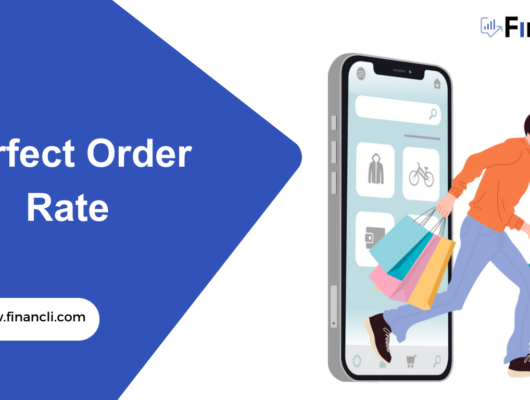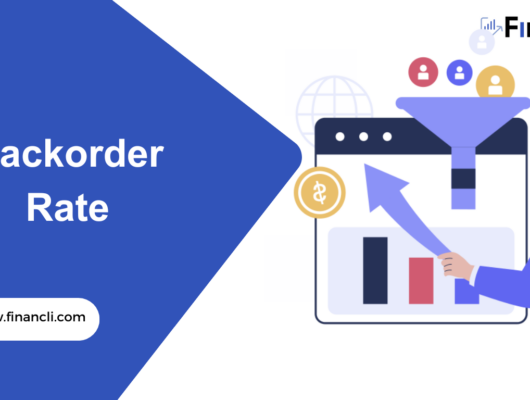List of All Retail KPIs You Will Ever Need
Are you ready to take your retail game to the next level? Then you’re in the right place. This article will give you a comprehensive list of all the retail KPIs you’ll ever need to know. So you can optimize your retail business and stay ahead of the ever-evolving competition.
The retail industry constantly changes, and businesses must adapt to stay relevant. In 2021, the retail industry generated over $4.06 trillion in sales in the US alone. That’s a lot of revenue, and it’s only going to grow. Retailers are continually evolving to meet the needs of their customers. And as a result, the industry is becoming more competitive.
In this context, if you imagine your retail business’s success without tracking the retail KPIs, you are setting yourself up for failure. You need to know which KPIs to track and how to interpret them to make the necessary changes quickly and accurately.
What is Retail KPIs?
Utilizing Retail KPIs, or Key Performance Indicators, is an effective way for retailers to monitor their success and evaluate how well they meet their objectives. These measurable metrics provide a comprehensive overview of the retail industry’s performance in both short-term and long-term results.
In short, Retail KPIs help retailers track their success and identify areas for improvement in various aspects of their business, such as sales, inventory management, customer engagement, and profitability.
Retail KPIs can include sales per square foot, gross margin, customer lifetime value, inventory turnover, conversion rate, and many more. Which is what this article or detailed guide is all about. And since we want every retailer to benefit from this guide, we have placed all the Retail KPIs into five categories:
- Sales Performance
- Inventory Management
- Customer Engagement
- Operational Efficiency
- Marketing Effectiveness
But before we jump into the comprehensive list, let’s take a quick look at the retail industry.
The Size and Scope of the Retail Industry
Are you curious about the retail industry? Do you want to know more about its size and scope? Let’s have a quick overview of why the retail industry is so big, how it has changed over time, and what its future looks like.
Retail Trends Over Time
The retail industry has seen some significant shifts in recent years. In the past, most stores were considered “bricks-and-mortar” establishments. Meaning they had physical locations for customers to shop at. However, with the rise of eCommerce, retailers have been forced to become more agile and adaptive to stay competitive in today’s market. As a result, many traditional stores now offer online shopping options and free shipping or delivery services.

In addition, retail stores are increasingly leveraging technology such as artificial intelligence (AI) and machine learning (ML). Because they need to gain insights into customer behavior and preferences. They could use this data to create highly personalized shopping experiences that cater to individual customers’ needs.
Size of the Retail Industry
The global retail market is estimated at around $30 trillion US dollars in 2023. This figure includes both online and offline sales from companies operating in all retail industry sectors. Which includes:
- food & beverage,
- fashion & apparel,
- home goods,
- electronics & appliances,
- beauty & health products,
- automotive parts & accessories,
- furniture & home décor items,
- sports equipment/clothing/shoes, etc.
The U.S. alone makes up approximately 22% of this market, with an annual value of almost $5 trillion USD!

As you can see from these figures, the retail industry is incredibly large. And it shows no signs of slowing down anytime soon. With technology rapidly changing how people shop online and in-store, retailers must continue innovating to remain competitive in this ever-evolving marketplace.
By staying ahead of the curve regarding trends and leveraging data-driven insights into customer preferences, retail businesses can ensure they remain at the forefront of this massive industry.
Understanding Different Business Models for Retail KPIs
As a retail business owner, it is crucial to understand the different models available. And how using the retail KPIs in conjunction with them can impact your success. Knowing which model best suits your needs and goals as a business can make all the difference between success and failure. So, let’s discuss various business models and how they can help you achieve your retail goals. Here are a few traditional ones, followed by modern ones.
Brick-and-Mortar

These businesses operate out of physical stores and have been around for decades. They offer customers a tangible shopping experience. This allows them to interact with products in person.
E-commerce

These businesses operate online. Customers can shop from the comfort of their own homes. E-commerce has exploded in popularity in recent years and shows no signs of slowing down.
Omni-Channel

These businesses have a both online and offline presence, providing customers with a seamless shopping experience across different channels. Many retailers are adopting this model to meet the demands of modern customers.
Direct-to-Consumer Model

The direct-to-consumer (DTC) model has become increasingly popular in recent years due to its ability to reach customers quickly and effectively. This model involves selling products directly to consumers through online stores or physical locations such as brick-and-mortar stores or kiosks. With this approach, there is no need for middlemen such as wholesalers or distributors. Meaning that retailers can keep more of their profits. Additionally, DTC businesses have greater control over pricing and product selection. This allows them to tailor their offerings to their target market.
Drop Shipping Model

The drop shipping model involves having a third party fulfill orders on behalf of the retailer. This means that retailers do not need to store any inventory themselves. Instead, they select items from wholesalers or manufacturers and have them shipped directly to customers. This eliminates the need for storing large amounts of inventory in warehouses or on shelves. Rather, retailers only purchase items when they receive an order from a customer. This results in lower overhead costs while still providing customers with fast delivery times.
Affiliate Marketing Model
Affiliate marketing is another business model that allows retailers to partner with other brands or websites. Then they can promote their products and services. It works because affiliates (i.e., partners) earn a commission each time they refer customers who purchase something from the retailer’s website or store. The affiliate then keeps a portion of the sale as a commission while passing the rest on to the retailer who originated the sale. Hence why we sometimes refer to it as “performance marketing.” Because both parties benefit from successful sales referrals. Affiliates are essential in helping retailers reach new audiences and grow their customer base without spending money on advertising campaigns or other costly promotions.
Retail businesses today have various options for choosing a successful business model that best fits their needs and goals. From direct-to-consumer models like drop shipping and DTC stores through affiliate marketing networks. It allows them greater flexibility in operating their business while still providing quality products at competitive prices. It’s vital for retailers wanting success today to be aware of these different models and understand how each one works. Only then can they capitalize on those opportunities which suit them best. With the right strategies and retail KPIs in place, retail businesses are sure to find success regardless of which model they choose.
Understanding the Latest Retail KPIs and Trends
As a retail business owner, staying current on the latest industry trends is critical. This will help you better understand what your customers want. It can also help inform your business strategy by allowing you to take advantage of new opportunities. To truly understand your business’s performance, you need to know where to look for the right retail KPIs. Let’s cover some of the latest trends in retail KPIs and how they can guide your decision-making process.
Personalization
One of the biggest trends in retail is personalization. Consumers increasingly expect retailers to tailor their products and services to meet their needs and preferences. This trend has led to an increased focus on customer loyalty programs and personalized recommendations based on past purchases and browsing history. As a result, retailers should track customer engagement metrics, such as repeat visits or average time spent on site. This way, they understand how well they’re meeting customer expectations.
Sustainability
In recent years, sustainability has become essential for many consumers when making purchasing decisions. As such, it’s important that retailers track sustainability-related retail KPIs. These can be energy consumption or waste management measures in order to demonstrate their commitment to environmental responsibility. Additionally, tracking metrics like carbon footprint or water usage can help retailers identify areas for improvement. Also, they can develop strategies for reducing their ecological impact over time.
Mobile Commerce
As more people turn towards mobile devices for shopping, mobile commerce is becoming increasingly important for retailers. To keep up with this trend, businesses should track KPIs like mobile app downloads or website visits from mobile devices. By doing so, they can gauge how successful their efforts are at engaging customers through these channels. Additionally, tracking retail metrics like conversion rates from mobile visitors can offer further insight into whether a website’s design is optimized for small screens and touchscreens.
Keeping up with the latest trends in retail KPIs can be daunting. But it doesn’t have to be impossible. By staying informed about changes in consumer behavior and monitoring retail KPIs that reflect those changes, you can ensure that your business stays ahead of the curve and remains competitive within the market landscape. Furthermore, understanding these trends will allow you to make data-driven decisions that will lead your business toward success!
Now that we have discussed the overview of this industry let’s look at all the retail KPIs you can use to assess your business’s performance.
Here are All the Retail KPIs You Have Been Looking For. . .
You must have seen other guides that compile all the Retail KPIs you need to measure your performance. But this guide is different. You will find not only the names of Retail KPIs. But also:
detailed definitions,
formulas/ equations, and
real-life examples or scenarios for each Retail KPI.
So, without further ado, let’s get started:
I. Sales Performance Retail KPIs

As a retail business owner, you must have an effective way of measuring the performance of your sales. These retail KPIs, especially the sales performance ones, provide you with the metrics you need to understand how well your retail business is performing. They enable you to track key retail metrics, such as revenue growth and customer acquisition. As well as you can measure progress towards your goals.
What Role do Sales Performance KPIs Play?
Sales performance KPIs play an important role in helping retail businesses assess their success or failure in reaching their objectives. By measuring these key indicators regularly, business owners can gain insight into areas they can improve. For example, if you notice that the average transaction size has decreased over time. Then this could indicate that customers may not find enough value in your products or services. On the other hand, if there has been an increase in customer satisfaction scores. Then this could mean that new initiatives, such as improved customer service, have positively impacted customers’ experiences with the company.
What Could Retail Business Owners Track Or Measure With Them?
Using sales performance KPIs enables retail business owners to track key metrics related to their businesses’ success or failure. This includes average transaction size, number of transactions per day/week/month, customer return rate, and customer satisfaction scores. Additionally, understanding these key indicators also helps retailers make better decisions regarding marketing strategies. Or product development. Which could further improve their bottom-line results over time.
Here is our first retail KPI related to sales.
1. Sales Per Square Foot
This Retail KPI measures the total sales generated according to the square footage of a store location. Retailers use this Retail KPI to compare different stores and assess their performance in terms of sales. Usually, higher sales per square foot indicate that a store is optimally stocked and utilizing its space efficiently.
Formula
Sales per Square Foot = Total Sales / Store Area (in sq ft)
Real-Life Example/Scenario
A retail store generates $500,000 in total sales over the course of six months. The store has 1000 square feet of space. Therefore, the Sales Per Square Foot would be: ($500,000 / 1000 sq ft) = $500 Sales Per Square Foot.
This indicates that the retailer generates $500 worth of revenue for every square foot of its store space.
2. Gross Margin Return on Investment
Who hasn’t heard about ROI or return on investment? But when we talk about Retail, we need Retail specific KPIs, which is why Retailers use ‘Gross Margin Return on Investment (GMROI). Retailers use GMROI to measure their profitability by considering the price of a product and its related costs. Higher GMROI indicates better efficiency in terms of inventory management and pricing.
Formula
GMROI = (Gross Profit / Cost of Goods Sold) × 100
Real-Life Example/Scenario
A retailer purchases 500 units of a product for $1,500. The retailer then sells the products for a total revenue of $2,000. Then the Gross Margin Return on Investment would be (($2,000 – $1,500) / $1,500) × 100 = 33%.
This indicates that the retailer generates a 33% return on their invested capital.
3. Average Transaction Value
Average Transaction Value or ATV Retail KPI measures the average amount customers spend during one transaction. Retailers use this Retail KPI to measure customer spending habits and identify areas of improvement for better conversions and sales. Higher ATV generally implies higher sales and profit margins.
Formula
ATV = Total Sales / Number Of Orders
Real-Life Example/Scenario
A retail store records total sales of $1000 from 10 orders monthly. Therefore, it would have an Average Transaction Value of ($1000 / 10 orders) = $100. This Retail KPI indicates that average customers are spending $100 per order.
4. Number of Transactions Per Customer
Retailers use this Retail KPI to measure the loyalty rate among their customers. It measures how many times a customer purchases in a given time period (typically one year). Retailers with more transactions per customer generally have better retention rates. And they tend to generate more revenue over time than those with lower numbers.
Formula
Number Of Transactions Per Customer = Total Number Of Orders / Total Number Of Customers
Real-Life Example/Scenario
A retail store has 500 customers who make a total of 1000 orders throughout the year. Then, the Number of Transactions per Customer would be (1000 orders / 500 customers) = 2 transactions per customer. This Retail KPI indicates that each customer made two purchases throughout the year.
5. Year Over Year Sales
This Retail KPI measures the total sales in a given year compared to previous years. It lets retailers compare their performance over time. And they use this Retail KPI to measure growth, identify trends, and adjust products or operations accordingly. Higher YOY sales indicate better performance from one year to another. On the other hand, a lower number of YOY sales obviously means lower performance than the previous year.
Formula
YOY Sales = Current Year’s Total Sales – Previous Year’s Total Sales
Real-Life Example/Scenario
A retail store had total sales of $500,000 in 2023 and total sales of $400,000 in 2022. Then the Year Over Year Sales would be ($500,000 – $400,000) = $100,000. This example indicates that the retailer grew their total sales by $100,000 from one year to another.
6. Sales Per Employee
This Retail KPI measures how productive each employee is in generating sales for the business. Retailers use it to measure individual performance as well as overall team performance. A higher number in this Retail KPI indicates more efficient and successful employees. It also indicates the employees who generate more hourly revenue than those with lower numbers.
Formula
Sales Per Employee = Total Sales Amount / Total Number Of Employees
Real-Life Example/Scenario
A retail store has 10 employees who generate $1000 in total sales. Then the Sales per Employee would be ($1000/10 employees) = $100. This Retail KPI indicates that each employee generates an average of $100 in sales per hour.
7. Sales Growth
Every retail business owner wants sales. But without measuring growth, it’s difficult to reach success. Retailers use this Retail KPI to measure the annual percentage increase from one year to another in terms of total sales. Higher numbers indicate higher sales and more profitability, while lower numbers mean a decrease in sales and profitability.
Formula
Sales Growth = (Current Sales – Previous Year’s Sales) / Previous Year’s Sales X 100
Real-Life Example/Scenario
A retail store had $400,000 in total sales in 2023 and $350,000 in total sales in 2022. Then the Sales Growth would be (($400,000 – $350,000)/$350,000) × 100 = 14%. This indicates that the retailer has grown its total sales by 14% from one year to another.
8. Online and Bricks and Mortar Sales
This Retail KPI measures the performance of a retailer’s stores. But it also measures their online presence. Retailers can gain insights into where they should invest more resources by looking at traditional physical stores and digital/online sales. Retailers should aim for higher numbers in both streams if they want to increase overall revenue.
Formula
Online and Bricks And Mortar Sales = (Total Online Sales + Total Store Sales) / 2
Real-Life Example/Scenario
A retail store has $300,000 in total online sales and $250,000 in total store sales for a given month. Then the Online and Bricks and Mortar Sales would be ($300,000 + $250,000) / 2 = $275,000. This Retail KPI indicates that the retailer has $275,000 combined online and physical store sales for the month.
9. Online to Real Life Traffic and Conversion
This Retail KPI measures how successful the store’s online presence is compared to its physical store performance. Retailers use it to compare traffic from visitors browsing their website vs. customers actually visiting their stores. Higher numbers indicate more success with online presence than physical locations.
Formula
Online To Real Life Traffic And Conversion = (Total Visitors To Website / Total Store Customers Visiting Location) X 100
Real-Life Example/Scenario
A retail store has 1,000 visitors to its website and 500 customers visiting it in a month. Then the Online To Real Life Traffic And Conversion would be (1,000 / 500) × 100 = 200%. This Retail KPI indicates that the website traffic is twice as high as the number of customers visiting the physical store location.
10. Year Over Year Growth
Year-over-year growth measures how much a retailer’s total sales have increased from one year to another. Retailers should aim for higher numbers as this indicates overall success and profitability. It also helps retailers determine if their strategies are working or not since it shows whether they have grown or declined over time.
Formula
Year Over Year Growth = (Current Sales – Previous Year’s Sales) / Previous Year’s Sales X 100
Real-Life Example/Scenario
A retail store had $400,000 in total sales in 2023 and $350,000 in total sales in 2022. Then the Year-over-Year Growth would be (($400,000 – $350,000)/$350,000) × 100 = 14%. This indicates that the retailer has grown its total sales by 14% from one year to another.
11. Sales by Category
Retailers track this Retail KPI to measure their performance for each product category. They should look for higher numbers for categories that are driving the highest revenue. Retailers can also use this information to focus on product categories needing more attention or resources.
Formula
Sales by Category = (Total Sales in Each Category / Total Overall Sales) X 100
Real-Life Example/Scenario
A retail store has $1,000,000 in total monthly sales, with $400,000 coming from clothing sales and $200,000 coming from home goods sales. Then the Sales by Category would be ($400,000/$1,000,000) × 100 = 40% for clothing and ($200,0000/$1000000) × 100 = 20% for home goods. This Retail KPI indicates that clothing is the most popular product category, representing 40% of total sales.
- Total Volume of Sales
The total Volume of Sales is a key performance indicator measuring a retailer’s total sales during a specific period. This KPI provides insights into a retail business’s overall performance and helps identify sales growth or decline trends. A higher number indicates greater sales volume, which can lead to increased profitability.
Formula
Total Volume of Sales = Sum of all Sales Transactions
Real-Life Example/Scenario
A retailer sold $500,000 worth of merchandise in a quarter and had 5,000 individual sales transactions during that same period. Then, the Total Volume of Sales would be $500,000.
13. Total Sales by Region
Total Sales by Region is a key performance indicator measuring a retailer’s sales in different regions or areas. This KPI helps retailers identify which regions are performing well and which need improvement. A higher number indicates that a particular region is generating more sales, while a lower number may indicate an opportunity for improvement.
Formula
Total Sales by Region = Sum of all Sales Transactions in a Particular Region
Real-Life Example/Scenario
A retailer has stores in three different regions: the East, West, and South. In a month, the retailer sold $200,000 worth of merchandise in the East, $150,000 in the West, and $100,000 in the South. Then, the Total Sales by Region would be $200,000 for the East, $150,000 for the West, and $100,000 for the South.
14. Total Orders
Total Orders are a key performance indicator that measures the total number of orders a retailer receives during a specific period. This KPI provides insights into the popularity of a retailer’s products or services and helps to identify trends in order volume. A higher number indicates greater orders, which can lead to increased revenue.
Formula
Total Orders = Number of Orders Received
Real-Life Example/Scenario
A retailer received 2,500 orders for their products in a week. Then, the Total Orders would be 2,500.
II. Inventory Management Retail KPIs

As a retail business owner, you understand how important it is to manage your inventory. Knowing what items are in stock, what items you need to order, and when to order are essential to running a successful retail business. But how can you make sure that your inventory management processes are efficient? That’s where inventory management KPIs come into play.
What Are Inventory Management KPIs?
Inventory management KPIs (Key Performance Indicators) are measurable values you can use to track the performance of specific organizational tasks. Retail business owners can gain valuable insights into their operations by tracking these indicators. They can also identify areas for improvement. In the context of inventory management, KPIs can help business owners understand how well their systems function. As well as, they can determine the best course of action for managing their inventories.
What Could Retail Business Owners Track or Measure with Them?
There are several different metrics that retail business owners can measure with inventory management KPIs. These include customer service levels, stock turnover rates, stock availability rates, cost of goods sold (COGS), and average order fill rate. By monitoring these metrics regularly, you can better understand your inventory situation. Then you can work toward improving your processes over time. Additionally, you can use the data from these metrics to inform future decisions about ordering new stock or optimizing existing processes.
In summary, inventory management is an essential part of running a successful retail business. With the right tools and strategies in place, you can ensure that your operations remain efficient while meeting customer demands in a timely manner. Inventory management KPIs provide invaluable insight into your operations by providing you with meaningful data that you can use to optimize your systems over time further. By taking advantage of these key performance indicators, you will be able to keep up with changes in demand more effectively and ensure that your customers always have access to the products they need when they need them most!
15. Inventory Turnover
Inventory Turnover is a key performance indicator that measures how quickly a retailer sells its inventory. It indicates the number of times the inventory is sold and replaced over a specific period of time. A higher inventory turnover indicates that a retailer efficiently manages its inventory and generates revenue.
Formula
Inventory Turnover = Cost of Goods Sold / Average Inventory
Real-Life Example/Scenario
A car dealership had a cost of goods sold of $500,000 and an average inventory value of $100,000. Using the formula, the inventory turnover would be 5 times per year.
16. Days of Inventory Outstanding
Days of Inventory Outstanding (DIO) is a KPI that measures how many days it takes a retailer to sell its inventory. It helps retailers to evaluate their inventory levels and efficiency in managing inventory.
Formula
DIO = (Inventory / Cost of Goods Sold) x 365
Real-Life Example/Scenario
A furniture store had an inventory value of $100,000 and a cost of goods sold of $50,000 per month. Using the formula, the DIO would be 73 days.
17. Shrinkage
Shrinkage is a KPI that measures the amount of inventory loss due to theft, damage, or errors. It helps retailers to identify and reduce losses in inventory and improve profitability.
Formula
Shrinkage = (Total Value of Inventory Losses / Total Value of Sales) x 100
Real-Life Example/Scenario
A convenience store had $5,000 worth of inventory losses due to theft, damage, and errors. The store had total sales of $100,000. Using the formula, the shrinkage rate would be 5%.
18. Sell-Through
Sell-Through is a KPI that measures how much of a retailer’s inventory is sold within a specific period of time. It helps retailers assess their products’ popularity and optimize their inventory levels.

Formula
Sell-Through = (Total Units Sold / Beginning Inventory) x 100
Real-Life Example/Scenario
An online clothing store had a beginning inventory of 1,000 units and sold 800 units within a month. Using the formula, the sell-through rate would be 80%.
19. Back Order Rate
Back Order Rate is a KPI that measures the number of customer orders that cannot be fulfilled due to stock shortages. It helps retailers to assess their inventory levels and optimize their ordering and stocking processes.
Formula
Back Order Rate = (Number of Back Orders / Total Number of Orders) x 100
Real-Life Example/Scenario
An electronics retailer received 100 orders for a popular laptop model but only had 80 units in stock, resulting in 20 backorders. Using the formula, the back order rate would be 20%.
20. Perfect Order Rate
Perfect Order Rate is a KPI that measures the percentage of orders that are fulfilled without any errors or issues. It helps retailers to assess their order fulfillment processes and improve customer satisfaction.
Formula
Perfect Order Rate = (Number of Perfect Orders / Total Number of Orders) x 100
Real-Life Example/Scenario
An online bookstore received 200 orders in a week, all fulfilled without any errors or issues. Using the formula, the perfect order rate would be 100%.
III. Customer Engagement Retail KPIs

Customer engagement KPIs—or key performance indicators—are metrics used to measure the effectiveness of a company’s customer engagement strategies. These metrics include things like website visits, social media interactions, email open rates, and more. By tracking these metrics, businesses can gain insight into how their customers engage with them online, which helps them optimize their strategies for maximum impact.
How Can Retail Business Owners Benefit from Using Customer Engagement KPIs?
Retail business owners can gain valuable insights into customers’ behaviors and preferences by tracking customer engagement KPIs. For example, if a business observes that its website visits spike during certain times or days of the week. Then it can use this information to adjust its marketing campaigns accordingly. Additionally, business owners can determine which channels work best for their target audience by measuring the effectiveness of different marketing channels (e.g., email vs. social media). So they can focus their efforts there accordingly. Finally, businesses can quickly identify areas needing improvement by monitoring social media interactions and customer reviews on sites like Yelp or Google My Business. And then there will be no hurdle in providing better experiences to customers.
So, using customer engagement KPIs is an effective way for retail business owners to gain valuable insights into their customers’ behaviors and improve their strategies accordingly. By paying attention to website visits, email open rates, social media interactions, and reviews left by customers online, businesses can ensure they are providing the best possible experience for their customers at all times—which is essential for long-term success in the retail industry!
21. Customer Retention
Customer retention is a key performance indicator (KPI) that measures a retailer’s ability to retain its customers over a certain period of time. It is an important KPI because acquiring new customers costs more than retaining existing ones. Therefore, it is important for retailers to focus on customer retention to improve profitability and maintain a loyal customer base.

The customer retention KPI measures the percentage of customers who return to make repeat purchases over a given time period. You can track it through different methods, such as customer surveys, customer data analysis, or loyalty program participation.
Formula
Customer Retention Rate = ((CE-CN)/CS)) X 100
Where
CE = Number of customers at the end of a period
CN = Number of new customers acquired during that period
CS = Number of customers at the start of that period
Real-life example/scenario
Suppose a retailer had 1,000 customers at the beginning of the year, and they acquired 200 new customers during the year. At the end of the year, they had 950 customers, out of which 850 were from the previous year. Using the formula, the customer retention rate would be ((950-200)/1000) x 100 = 75%. This means that 75% of the retailer’s existing customers returned to make repeat purchases over the year.
By tracking customer retention rates, retailers can identify the reasons for customer churn and develop strategies to improve customer satisfaction, loyalty, and retention. For example, a retailer can offer personalized promotions, improve customer service, or enhance the shopping experience to keep customers engaged and coming back.
22. Customer Satisfaction
Customer satisfaction is another important KPI for retail businesses as it measures how well a business meets the needs and expectations of its customers. It is a measure of customer loyalty and can be used to determine how successful a business’s marketing efforts are in engaging existing customers and attracting new ones.

A high customer satisfaction score indicates that the retailer provides good products and services that make customers happy. A low score, on the other hand, suggests that something needs to be changed or improved to satisfy customers better.
Formula
CSAT = (Number of Satisfied Customers / Total Number of Customers) X 100
Where CSAT stands for Customer Satisfaction.
Real-life example/scenario
For example, a retailer surveys its customers, asking them to rate their shopping experience on a scale from 1 (very unsatisfied) to 5 (very satisfied). If the retailer receives 90 responses with an average rating of 4.5 out of 5, then the customer satisfaction score would be calculated as follows:
CSAT = (90 x 4.5 / 100) x 100 = 405
This means that the customer satisfaction score for this particular retailer is 405 out of 500, which is quite high and indicates that the customers are generally happy with their shopping experience.
By tracking customer satisfaction scores, retailers can identify areas needing improvement to meet customer needs and expectations better. This will help them formulate strategies to improve customer satisfaction and loyalty, leading to increased sales.
23. Basket size/items per transaction
Basket size or items per transaction is a key performance indicator (KPI) for retailers that measures the average number of items customers purchase during each shopping trip. It is an important KPI because it helps retailers understand the purchasing behavior of their customers and allows them to adjust their product mix accordingly.
The basket size KPI can be tracked using different methods, such as checkout data analysis, customer surveys, and loyalty program participation.
Formula
Basket Size = (Total Number of Items Purchased / Total Number of Transactions)
Real-life example/scenario
For example, a retailer has sold 200 items in the last month and had 100 transactions. According to the formula, the basket size for this retailer would be 2 items per transaction. This means customers, on average, purchase two items each time they enter the store.
By tracking basket sizes, retailers can understand what products their customers buy together and tailor their product mix accordingly. For instance, if a retailer notices that certain products tend to be purchased together more often than not, they can consider adding more items to boost sales.
24. Units per Transaction
Units per transaction is a KPI that measures the number of individual units (e.g., items, products) purchased by a customer during each shopping trip. It is an important KPI for retailers as it helps them understand the purchasing behavior of their customers and adjust their product mix accordingly.
Formula
The formula for calculating units per transaction is:
Units Per Transaction = (Total Number of Units Sold / Total Number of Transactions)
Real-life example/scenario
For example, a retailer has sold 1,000 items in the last month and had 500 transactions. According to the formula, the units per transaction for this retailer would be 2 units per transaction. This means that, on average, customers purchase two items each time they enter the store.
By tracking units per transaction, retailers can identify popular items among their customers and stock more of them to boost sales. Additionally, they can use this data to group certain items and create packages or bundles, which may increase sales.
25. Shopper Dweller Time
Shopper dweller time is a key performance indicator (KPI) in retail that measures the average amount of time shoppers spend inside a store or a specific area of a store. This KPI helps retailers understand how engaging their store layout and product displays are to customers and how long it takes them to complete their shopping journey. By analyzing shopper dweller time, retailers can identify areas where shoppers spend more time. And use that information to improve store layout and increase sales.
Formula
Shopper Dweller Time = Total Time Spent by All Shoppers / Number of Shoppers
Real-life example/scenario
Suppose a retailer operates a store that serves 1,000 shoppers in a day, and they monitor shopper dweller time for the entire store. They found that the total time shoppers spent inside the store during that day was 6,000 minutes. Using the formula, the shopper dweller time would be 6,000 / 1,000 = 6 minutes. This means that, on average, shoppers spent six minutes inside the store.
Overall, the shopper dweller KPI is a valuable tool for retailers to optimize store layout and product displays, enhance the customer experience, and increase sales.
26. Return Reason
Return Reason is a key performance indicator (KPI) in retail that measures the primary reasons why customers return products to the store. This KPI helps retailers identify the most common reasons for returns, allowing them to improve their product offerings, customer service, and marketing strategies to reduce the number of returns and improve customer satisfaction.
Formula
To calculate the return reason KPI, retailers need to collect data on the reasons for each return. Then analyze the data to identify the most common reasons. You can calculate it by dividing the number of returns for a specific reason by the total number of returns during a given time period.
Return Reason KPI = Number of Returns for a Specific Reason / Total Number of Returns
By analyzing the data, retailers can identify the most common reasons for returns, such as product defects, incorrect sizing, or damaged goods during shipping.
Real-life example/scenario:
Suppose a retailer operates a clothing store, and they analyze return reasons for the month of February. They found that out of 100 returns, 20 were due to product defects, 30 were due to incorrect sizing, and 50 were due to customer preference. Using the formula, the return reason KPI for product defects would be 20 / 100 = 0.2 or 20%, while the KPI for incorrect sizing would be 30 / 100 = 0.3 or 30%.
IV. Operational Efficiency Retail KPIs

Operational efficiency KPIs compare the output of goods or services against the inputs that go into producing them. This metric allows businesses to measure how effective their operations are. This enables them to identify areas to improve and become more efficient. In the retail industry, utilizing operational efficiency KPIs can be incredibly beneficial for business owners. Especially for those who want to track and measure key performance indicators.
What are Operational Efficiency KPIs?
Operational efficiency KPIs are metrics that measure how productive a business is in terms of its inputs versus outputs. By tracking these metrics, retailers can gain valuable insight into their operations and identify areas that need improvement to be more efficient.
How Can Retailers Leverage Operational Efficiency KPIs?
Retailers can leverage operational efficiency KPIs in a variety of ways. For example, by tracking the inventory turnover rate, retailers can determine how quickly they move products from their warehouses to customers’ homes. Additionally, measuring the order fulfillment rate will allow businesses to determine how accurately orders are processed and shipped. They can then use this data to make adjustments if necessary. Finally, monitoring customer satisfaction rates will show retailers how well customers receive their products and services, allowing them to refine their offerings over time.
Thus, operational efficiency KPIs can be incredibly useful for retail businesses that want to understand better how efficiently they operate. By tracking metrics such as inventory turnover rate, order fulfillment rate, on-time delivery rate, and customer satisfaction rate, retailers can gain valuable insight into their operations and identify areas that need improvement to increase efficiency levels. Ultimately, leveraging operational efficiency KPIs enables businesses in the retail industry to stay competitive in today’s ever-changing market landscape.
27. Interest Coverage Ratio
The interest coverage ratio measures a company’s ability to repay its interest expense on its debt. You can calculate it by dividing the company’s earnings before interest and taxes (EBIT) by its total interest payments during the same period.
The ICR is a significant financial metric as it indicates how easily a business can meet its obligations to creditors. A low ICR suggests that the firm may not have enough income or cash flow to cover its debt payments. This can cause concern for lenders. On the other hand, if a company has a high ICR. Then it generates more than enough earnings to cover its interest expense.
Formula
Interest coverage ratio = EBIT/ Interest Payment
Real-life example or scenario
A retailer has an EBIT of $150,000 and total interest payments of $30,000 for the quarter. Therefore, the company’s ICR is 5 (150,000 / 30,000). This high value indicates that the business generates more than enough earnings to cover its interest expense. This would be a positive sign for lenders assessing the company’s financial strength.
28. Return on Assets (ROA)
Return on assets (ROA) is a key financial metric that measures how profitable a company is relative to its total assets. It helps investors evaluate if the firm is making efficient use of its resources and capital or not.
ROA can be calculated by dividing net income by total assets during the same period. A higher ROA indicates that the company generates more profits from its investments than other companies in the same industry.
Formula
Return on Assets = Net Income/ Total Assets
Real-life example or scenario
For example, a retail clothing store has a net income of $1,000,000 and total assets of $4,000,000 for the year. Therefore, their ROA is 25% (1,000,000 / 4,000,000). This high value indicates that the company generates more profits from its assets than other companies in the same industry. Consequently, investors may consider this business to be a good investment opportunity.
29. Gross Profit Margin
Gross profit margin is a financial measure to assess a company’s profitability and efficiency. It calculates how much of every dollar the business receives is retained as profit after production costs are removed from each sale.
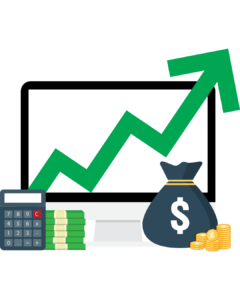
The gross profit margin can be calculated by subtracting the cost of goods sold (COGS) from total revenues, then dividing this figure by total revenues for the same period. The higher the gross profit margin, the more efficiently a business generates profits.
Formula
Gross Profit Margin = (Revenue – Cost of Goods Sold) / Revenue
Real-life example or scenario
A retail store has total revenues of $10,000, and the cost of goods sold (COGS) is $7,500 for the month. Therefore, their gross profit margin is 25% ((10,000 – 7500) / 10,000). This value indicates that the company retains 25 cents in profits from each dollar it receives from sales. This suggests that the company is efficient at generating profits and may be a good investment opportunity for investors.
30. EBIT Margin
EBIT margin is a key profitability metric that measures a business’s ability to generate profits from its operations. It factors in both revenue and expenses, including taxes, interest payments, and other operating costs (OPEX), to determine the company’s bottom-line performance.
EBIT margin can be calculated by dividing earnings before interest and taxes (EBIT) by total revenues for the same period. A higher EBIT margin indicates a more profitable business since it can better generate returns on its investments.
Formula
EBIT Margin = Earnings Before Interest & Taxes / Total Revenue
Real-life example or scenario
A retail store has an EBIT of $1,000,000 and total revenues of $5,000,000 for the year. Therefore their EBIT margin is 20% (1,000,000 / 5,000,000). This value suggests that the business generates 20 cents in profits from every dollar it takes in. Consequently, investors may consider this company a good investment opportunity due to its high investment returns.
31. Cost of Goods Sold (COGS)
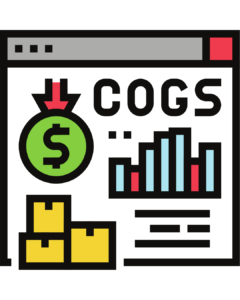
Cost of goods sold (COGS) is an important financial metric to assess a company’s profitability. It measures how much money a business spends to create or acquire the products and services it sells for revenue. COGS includes direct labor, raw material, and manufacturing overhead expenses associated with each sale.
Formula
Cost of Goods Sold = Direct Labor + Raw Materials + Manufacturing Overhead
Real-life example or scenario
A retail store has total revenues of $10,000 but a direct labor cost of $1,500, raw material expenses of $2,500, and manufacturing overhead expenses of $1,000. Therefore their COGS is $5,000 ((1,500 + 2,500 + 1,000 = 5,000)). This figure indicates that the company spends 50% (5,000 / 10,000) of its revenue to make each sale. Consequently, investors may consider this business a good investment opportunity due to its high efficiency in generating profits.
32. Operating Expense (OPEX)
Operating expense (OPEX) is the total amount of money a retailer spends on its daily business operations. This includes expenses such as rent, utilities, salaries, marketing costs, and other overhead costs. The OPEX KPI is calculated by dividing the total operating expenses by the company’s revenue. A high OPEX ratio indicates that the retailer is spending significant revenue on operating expenses, which can affect its profitability.
Formula
OPEX ratio = Total Operating Expenses / Revenue
Real-life example or scenario
A retailer has a total operating expense of $100,000 and generates revenue of $500,000 in a quarter. Therefore, the company’s OPEX ratio is 0.2 (100,000 / 500,000). This indicates that the retailer spends 20% of its revenue on operating expenses. A low OPEX ratio is typically better as it indicates that a retailer is more efficient in managing its operating expenses and generating profits.
33. Quick Ratio
The quick ratio is a liquidity ratio that measures a retailer’s ability to meet its short-term financial obligations. It’s calculated by dividing the company’s liquid assets (cash, marketable securities, and accounts receivable) by its current liabilities. This ratio excludes inventory from its calculation because it is considered less liquid.
Formula
Quick Ratio = (Cash + Marketable Securities + Accounts Receivable) / Current Liabilities
Real-life example or scenario
A retailer has $200,000 in cash, $50,000 in marketable securities, and $100,000 in accounts receivable. The company’s current liabilities amount to $300,000. Therefore, the retailer’s quick ratio is 0.83 (($200,000 + $50,000 + $100,000) / $300,000). This indicates that the retailer has enough liquid assets to cover 83% of its short-term financial obligations.
34. Current Ratio
The current ratio is another liquidity ratio that measures a retailer’s ability to meet its short-term financial obligations. Retailers typically estimate it by dividing the company’s assets by its liabilities. Current assets include cash, inventory, accounts receivable, and other assets easily converted to cash within a year.
Formula
Current Ratio = Current Assets / Current Liabilities
Real-life example or scenario
A retailer has current assets of $500,000 and current liabilities of $300,000. Therefore, the company’s current ratio is 1.67 ($500,000 / $300,000). This indicates that the retailer has enough current assets to cover 1.67 times its current liabilities. A higher current ratio is generally better, indicating that a retailer can meet its short-term financial obligations.
35. Accounts Payable Turnover (APT)
Accounts payable turnover (APT) is a financial ratio measuring how often a retailer pays off its accounts payable during a specific period. You can calculate it by dividing the cost of goods sold (COGS) by the average accounts payable balance.
Formula
APT = COGS / Average Accounts Payable Balance
Real-life example or scenario
A retailer has a COGS of $1,000,000 and an average accounts payable balance of $250,000. Therefore, the company’s APT is 4 ($1,000,000 / $250,000). This indicates that the retailer pays off its accounts payable four times during the period. A higher APT is generally better as it indicates that a retailer pays its bills on time and has a good relationship with its suppliers.
36. Days Payables Outstanding (DPO)
Days Payables Outstanding (DPO) is a financial metric measuring the average number of days a retailer takes to pay its suppliers after receiving goods or services. You can calculate it by dividing the total accounts payable by the average daily cost of goods sold. DPO indicates how efficiently a retailer manages its working capital and how quickly it pays off its debts to suppliers.
Formula
DPO = (Accounts Payable / Cost of Goods Sold) x Days
Real-life example or scenario
A retailer has accounts payable of $100,000 and cost of goods sold of $1,000,000 for the quarter. The DPO for the retailer would be calculated as follows:
DPO = ($100,000 / $1,000,000) x 90 = 9 days
This indicates that it takes the retailer an average of 9 days to pay its suppliers after receiving goods or services.
37. Cash Conversion Cycle (CCC)
The Cash Conversion Cycle (CCC) measures the time it takes for a retailer to convert its inventory investment into cash received from sales. It includes three components: days inventory outstanding (DIO), days sales outstanding (DSO), and days payable outstanding (DPO). CCC helps retailers to determine the efficiency of their working capital management and cash flow.
Formula
CCC = DIO + DSO – DPO
Real-life example or scenario
A retailer has an average inventory of $100,000, a cost of goods sold of $500,000, accounts receivable of $50,000, and accounts payable of $20,000. The DIO, DSO, and DPO are calculated as 30, 15, and 10 days, respectively. The CCC for the retailer would be calculated as follows:
CCC = 30 + 15 – 10 = 35 days
This indicates that it takes the retailer an average of 35 days to convert its inventory investment into cash received from sales.
38. Monthly Revenue Per Employee
Monthly Revenue Per Employee measures how much revenue a retailer generates per employee in a given period. It helps retailers evaluate their workforce’s productivity and determine if they are generating enough revenue to cover labor costs.
Formula
Monthly Revenue Per Employee = Total Revenue / Number of Employees / Months
Real-life example or scenario
A retailer has a total revenue of $500,000 and 50 employees for the month. The Monthly Revenue Per Employee would be as follows:
Monthly Revenue Per Employee = $500,000 / 50 / 1 = $10,000
This indicates that the retailer generates $10,000 in monthly revenue per employee.
39. Operating Cash Flow Ratio (OCF)
The Operating Cash Flow Ratio (OCF) measures a retailer’s ability to generate cash from its operations to cover its operating expenses. It indicates whether a retailer has enough cash flow to fund its day-to-day operations.
Formula
OCF = Operating Cash Flow / Total Operating Expenses
Real-life example or scenario
A retailer has an operating cash flow of $100,000 and total operating expenses of $200,000 for the quarter. The OCF for the retailer would be as follows:
OCF = $100,000 / $200,000 = 0.5
This indicates that the retailer generates 50 cents of cash flow from operations for every dollar of operating expenses.
40. Current Accounts Receivable
Current Accounts Receivable (AR) is a key retail metric that measures the value of outstanding customer invoices. It is used to measure the financial health of a business by monitoring its ability to collect payments from customers on time.
The AR KPI can be calculated by adding up all the unpaid customer account balances, such as those related to goods or services sold during the period. A higher current accounts receivable indicates an increase in cash flow, while lower values indicate difficulty in collecting customer payments and may lead to liquidity issues.
Formula
Current Accounts Receivable = Outstanding Customer Invoices / Total Revenues
Real-life example or scenario
A retail store has $500,000 in outstanding customer invoices and total revenues of $2,000,000 for the year. Therefore their current accounts receivable is 25% (500,000/ 2,000,000). This value suggests that the business has difficulty collecting timely payments from customers.
41. Current Accounts Payable
Current Accounts Payable (AP) is a key retail metric that measures the amount of money owed to vendors for goods and services purchased during the period. It monitors a business’s financial health by determining its ability to pay off debt obligations on time.
The AP KPI can be calculated by adding up all unpaid vendor bills or account balances over a certain period of time. A higher current accounts payable indicates an increase in cash flow, while lower values indicate difficulty in paying off debts and may lead to liquidity issues.
Formula
Current Accounts Payable = Outstanding Vendor Bills / Total Revenues
Real-life example or scenario
A retail store has $500,000 in outstanding vendor bills and total revenues of $2,000,000 for the year. Therefore their current accounts payable is 25% (500,000/ 2,000,000). This value suggests that the business has difficulty paying off its obligations on time.
42. Average Invoice Processing Cost
Invoice processing in retail is the process of verifying, approving, and recording invoices to ensure accuracy and facilitate payment. Average Invoice Processing Cost (APC) is a key retail metric measuring the average cost incurred for invoice processing. It helps retailers identify areas where they can reduce costs associated with invoice processing.
Formula
Average Invoice Processing Cost = Total Cost of Processing Invoices / Number of Invoices Processed
Real-life example or scenario
A retailer has total costs of $20,000 for processing 100 invoices during the month. Therefore their Average Invoice Processing Cost would be:
Average Invoice Processing Cost = $20,000 / 100 = $200
This value suggests that it costs the retailer $200 to process each invoice.
43. Payroll Headcount Ratio

Payroll Headcount Ratio is a key retail metric measuring the number of employees required to generate a certain amount of revenue. It helps retailers identify areas where they can reduce costs associated with payrolls. For example, by cutting down on employee headcount or increasing productivity and efficiency.
Formula
Payroll Headcount Ratio = Total Payroll Cost / Total Revenues
Real-life example or scenario
A retailer has total payroll cost of $1,000,000 and total revenues of $2,500,000 for the year. Therefore their Payroll Headcount Ratio would be:
Payroll Headcount Ratio = 1,000,000 / 2,500,000 = 0.4
This value suggests that the retailer requires 4 employees for every $10,000 in revenue generated.
44. Fixed Asset Turnover
Fixed Asset Turnover is a key retail metric measuring the efficiency of using fixed assets to generate sales. It helps retailers identify areas where they can increase efficiency and reduce costs associated with asset management.
Formula
Fixed Asset Turnover = Total Revenues / Average Net Fixed Assets
Real-life example or scenario
A retailer has total revenues of $2,500,000 and average net fixed assets of $1,000,000 for the year. Therefore their Fixed Asset Turnover would be:
Fixed Asset Turnover = 2,500,000 / 1,000,000 = 2.5
This value suggests that the retailer’s fixed assets generate $2.50 in sales for every dollar invested.
45. Selling, General, and Administrative Ratio (SGA)
The selling, General, and Administrative (SGA) Ratio is a key retail metric measuring the number of a company’s expenses related to selling and administrative activities relative to total revenue. It helps retailers identify areas to reduce overhead costs associated with these activities.
Formula
Selling, General, and Administrative Ratio (SGA) = Total Expenses Related to Selling & Administrative Activities / Total Revenues
Real-life example or scenario
A retailer has total expenses for selling & administrative activities of $500,000 and total revenues of $2,500,000 for the year. Therefore their SGA Ratio would be:
Selling, General, and Administrative Ratio (SGA) = 500,000 / 2,500,000 = 0.2
This value suggests that the retailer spends 20 cents out of every dollar earned on selling and administrative activities. To reduce costs associated with these activities, they should review their processes and look for areas where efficiency can be improved.
V. Marketing Effectiveness Retail KPIs

Are you a retail entrepreneur looking for ways to optimize your marketing efforts? Understanding and tracking marketing effectiveness is key to ensuring your strategies work. Here is an overview of marketing effectiveness and how tracking key performance indicators (KPIs) can help retailers track their marketing efforts.
What is Marketing Effectiveness?
Marketing effectiveness is the measurement of the success of a company’s promotional campaigns by comparing the amount invested in them with the associated return on investment (ROI). It measures how well a company’s money is spent on its various campaigns and helps inform decisions about where to invest more or fewer resources in future initiatives. In other words, it helps companies understand whether or not their campaigns have their intended effect.
Retailers use several different KPIs to measure marketing effectiveness. By tracking these metrics over time, retailers can gain insight into which strategies are succeeding and which may need improvement. For example, if a retailer notices that their cost per customer acquisition has been steadily increasing, they can investigate why this might happen and adjust their approach accordingly. Tracking KPIs provides valuable insight into what’s working and what isn’t so that retailers can make informed decisions about allocating their resources best moving forward.
46. Conversion Rate
Conversion rate is a key retail metric measuring the percentage of customers who take action (e.g., buying something, signing up for a newsletter, etc.) after visiting your website or store. It helps retailers measure their marketing efforts’ success and provides important feedback about what is and isn’t working.
Formula
Conversion Rate = Number of Actions Taken / Total Visitors
Real-life example or scenario
A retailer has 500 visitors to their website in a month, and 40 make a purchase. Therefore their conversion rate would be:
Conversion Rate = 40 / 500 = 8%
This value suggests that 8% of visitors to the website are making a purchase, which can help inform decisions about where to focus marketing efforts in the future. If the conversion rate is lower than desired, retailers may need to review their website design or advertising strategies to increase the rate of customer action.
47. Foot and Digital Traffic
Foot and digital traffic is a retail metric that measures the total number of people who visit your store (foot traffic) and go to your website (digital traffic) in physical and online locations. Measuring customer engagement levels across multiple channels helps retailers understand their promotional campaigns’ success.
Formula
Foot & Digital Traffic = Total Number of Store Visitors + Total Web Visits
Real-life example or scenario
A retailer has 200 visitors to their store in a week and 500 visits to their website. Therefore their Foot & Digital Traffic would be:
Foot & Digital Traffic = 200 + 500 = 700
The figure indicates that the retailer has had a combined footfall of 700 visitors to their physical store and website during a week. This data could assist retailers in determining the most effective ways to reach their intended audience. If the number is insufficient, retailers may need to alter their promotional techniques or evaluate the feasibility of incorporating new marketing avenues.
48. Click-Through Rate (CTR)
Click-through rate (CTR) is a retail metric used to measure the percentage of people who click on an advertisement after seeing it. It helps retailers understand the effectiveness of their advertising campaigns by measuring engagement levels with potential customers.
Formula
CTR = Number of Clicks / Total Impressions
Real-life example or scenario
The CTR calculation of a retailer’s advertisement reveals that out of 100,000 impressions, 500 individuals clicked on it. This indicates that only 0.5% of individuals who viewed the advertisement interacted with it, which can provide insights into making informed decisions regarding future campaign investments. If the CTR value is not satisfactory, retailers may have to evaluate the ad’s design or placement to boost customer engagement and click-through rates.
VI. Miscellaneous Retail KPIs

49. Order Status
As a significant retail metric, order status provides insights into the efficiency of fulfilling customer orders across various channels like physical stores, online platforms, and more. This KPI allows retailers to gauge their operational efficacy by measuring the time taken to process orders and deliver them to customers within the expected timeframe. Keeping a close eye on this metric helps retailers identify bottlenecks in their order fulfillment process and make informed decisions to streamline operations and improve customer satisfaction.
Formula
Order Status = Number of Completed Orders / Total Orders
Real-life example or scenario
A retailer has 100 orders to be fulfilled in a week, and 90 are completed on time. Therefore their order status would be:
Order Status = 90 / 100 = 90%
According to this metric, the retailer has achieved a 90% success rate in fulfilling orders on time, which can provide useful insights for managing resources efficiently in the future. If the order status falls below the desired level. Then retailers should consider re-evaluating their supply chain and customer service processes to improve order fulfillment speed.
50. Earnings Per Share (EPS)
Earnings per share (EPS) is a retail metric used to measure the profitability of a company’s shares. It helps retailers understand their financial performance by measuring how much profit each share generates and allows investors to compare different companies in the same industry.
Formula
EPS = Net Income / Number of Outstanding Shares
Real-life example or scenario
A retailer has a net income of $200,000 and 10,000 outstanding shares. Therefore their EPS would be:
EPS = 200,000 / 10,000 = $20
This value suggests that for every share the retailer has, they will make a profit of $20. This can help inform decisions about allocating resources and maximizing their financial performance. If the EPS is lower than desired, retailers may need to review their pricing strategy or consider other methods of cost-cutting to increase profit margins.
51. Budget Variance
Budget variance is a retail metric used to measure the difference between budgeted amounts and actual spending levels. It helps retailers understand their success in planning and executing their budgets by measuring if they can stay within predetermined financial limits.
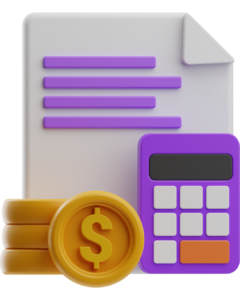
Formula
Budget Variance = Actual Spending – Budgeted Amounts
Real-life example or scenario
A retailer has budgeted $500,000 for their promotional campaign but spent $550,000 on it. Therefore their budget variance would be:
Budget Variance = 550,000 – 500,000 = $50,000
This value indicates that the retailer has exceeded their promotional budget by $50,000. This information is critical for making informed decisions about managing resources moving forward. When the budget variance is higher than desired, retailers should reevaluate their budgeting process or explore other options to spend their money more effectively.
52. Budget Creation Cycle Time
Budget creation cycle time is a retail metric you can use to measure the amount of time taken for budgeting processes. It allows retailers to understand their ability to plan, strategize, and create accurate budgets in a timely manner.
Formula
Budget Creation Cycle Time = Total Time Spent Creating Budget / Number of Budgets Created
Real-life example or scenario
A retailer took 2 weeks to create 10 different budgets. Therefore their budget creation cycle time would be:
Budget Creation Cycle Time = 14 Days / 10 Budgets = 1.4 Days
By looking at the data, we can see that the retailer took an average of 1.4 days to create each budget. This information sheds light on their budgeting process’s efficiency and helps identify any bottlenecks or areas that require improvement. Retailers who aim to speed up the budget creation cycle should consider streamlining their process to produce more accurate budgets in less time.
53. Line Items in Budget
The retail metric, line items in a budget, measures the level of detail in a budget by counting the number of individual expenses that make up the budget. It helps retailers understand how comprehensive their budgets are and how detailed their spending plans are. In other words, it quantifies the number of specific items included in a budget, allowing retailers to evaluate the level of granularity and specificity in their financial planning.
Formula
Line Items in Budget = Number of Expenses / Total Budget Value
Real-life example or scenario
A retailer has a total budget value of $500,000 with 50 different expenses. Therefore their line items in the budget would be:
Line Items in Budget = 50 Expenses / 500,000 = 0.01
This value is calculated by dividing the total number of line items in the budget by the total amount spent. In this case, the result is an average of 0.01 line items per dollar spent. This information is important because it helps retailers understand the level of detail and granularity in their budgeting process. If the value is too low, it may indicate that the budget is not detailed enough to track expenses accurately. To improve the accuracy of budgeting, retailers should consider breaking down larger expenses into smaller, more specific line items.
54. Number of Budget Iterations
The number of budget iterations is a retail metric used to measure how often a budget has been revised or updated. It allows retailers to understand their ability to stay on top of changing market conditions by measuring the frequency at which they review and adjust their budgets accordingly.
Formula
Number of Budget Iterations = Total Number of Revisions / Total Number of Budgets
Real-life example or scenario
A retailer has revised their 10 budgets a total of 20 times. Therefore their number of budget iterations would be:
Number of Budget Iterations = 20 Revisions / 10 Budgets = 2
This value indicates that the retailer has revised each budget twice on average. This helps them identify opportunities to optimize their budgeting process and ensure they are taking advantage of changing market conditions. When the budget iteration rate is lower than expected, retailers should consider reviewing their budgets more often to stay ahead in the market.
Final Thoughts
In conclusion, the retail industry is constantly evolving. And retailers must stay on top of their game to remain competitive. So, understanding and utilizing the right retail KPIs can help retailers make informed decisions, improve their operations, and ultimately drive success.
Sales performance, inventory management, customer engagement, operational efficiency, and marketing effectiveness are critical for retailers to measure and track.
By analyzing these KPIs, retailers can gain valuable insights into their business and make data-driven decisions to improve their bottom line.
Keeping up with the latest retail trends and utilizing the most relevant KPIs for their specific business model can help retailers stay ahead of the curve and achieve their goals.
With this extensive list of retail KPIs, retailers have a valuable resource to guide their efforts and drive success in the ever-changing world of retail.


